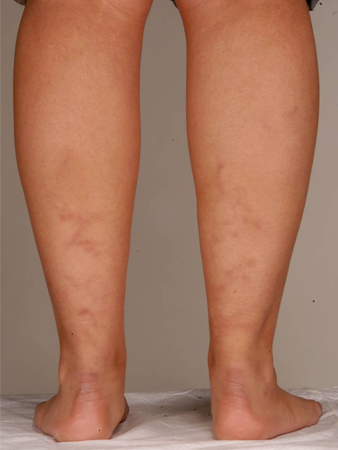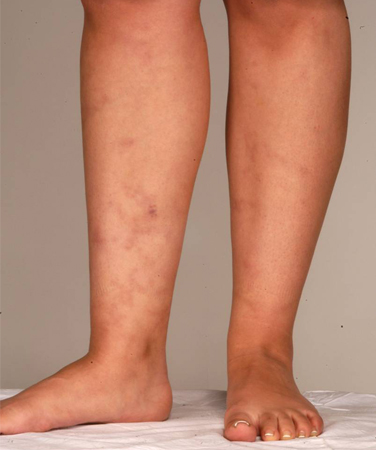History and exam
Key diagnostic factors
common
history or current diagnosis of vascular thrombosis
History of one or more episodes of venous, arterial, or microvascular thrombosis confirmed by objective imaging or histopathology. This includes the less common presentations of stroke, coronary artery thrombus, peripheral arterial disease, and renal thrombotic microangiopathy.[4]
history of pregnancy loss
Three or more consecutive pregnancy losses at <10 weeks' gestation and/or unexplained fetal death >10 weeks' gestation.[4]
uncommon
history of pregnancy-associated morbidity
Premature delivery (<34 weeks' gestation) due to pre-eclampsia, placental abruption, or intrauterine growth restriction (i.e., signs of placental insufficiency).
Other diagnostic factors
common
history of systemic lupus erythematosus
Up to 36% of patients with APS have a history of systemic lupus erythematosus, and another 5% have a lupus-like syndrome.[4]
features of thrombocytopenia
May be present in APS, often due to an immune mechanism or the presence of another autoimmune disease (idiopathic thrombocytopenic purpura). The incidence of haemorrhage associated with this is rare. Features of thrombocytopenia include petechial rash or symptoms of mucosal bleeding.
arthralgia/arthritis
Complaints of arthralgia (39%) and arthritis (27%) are common and are either due to underlying systemic lupus erythematosus or lupus-like disease (if the patient does not have enough criteria to fulfil the definition of systemic lupus erythematosus).[4]
livedo reticularis
This mottled purplish discoloration of the skin, which can be blanching or non-blanching on pressure, is present in up to 20% of patients with APS. The non-blanching livedo reticularis is due to fibrin deposition at the periphery of the circulation of skin arterioles.[Figure caption and citation for the preceding image starts]: Livedo reticularisFrom the personal teaching collection of Professor Hunt; used with permission [Citation ends]. [Figure caption and citation for the preceding image starts]: Livedo reticularisFrom the personal teaching collection of Professor Hunt; used with permission [Citation ends].
[Figure caption and citation for the preceding image starts]: Livedo reticularisFrom the personal teaching collection of Professor Hunt; used with permission [Citation ends].
uncommon
history of other rheumatological disorders or connective tissue disorders
Evaluation of a large cohort of patients with APS showed that non-lupus-like rheumatological disorders occurred in the following frequencies: primary Sjogren syndrome (2.2%), rheumatoid arthritis (1.8%), systemic sclerosis (0.7%), systemic vasculitis (0.7%), and dermatomyositis (0.5%).[4]
cardiac murmur
Vegetations, valve thickening, and heart valve dysfunction seem to be more frequent in APS than in patients with systemic lupus erythematosus alone. This is known as Libman-Sacks endocarditis and may relate to fibrin deposition on the valves. The mitral valve is most commonly affected. Up to 20% of patients with APS have valve abnormalities, although they rarely cause haemodynamic problems.[40]
oedema
Patients occasionally present with signs or symptoms of nephropathy (oedema and proteinuria) due to microangiopathic thrombosis secondary to antiphospholipid syndrome.[31]
seizure, headache, memory loss, signs of transverse myelopathy
Patients presenting with stroke or transient ischaemic attack, especially if <50 years of age, should raise suspicion for an underlying diagnosis of APS. Less common neurological presentations include seizure, headache, memory loss, transverse myelopathy, and rarely chorea gravidarum in pregnancy.[32][33]
limb discomfort, swelling, skin discoloration, and ulcers
Up to 30% of patients can experience post-phlebitic syndrome following an episode of deep vein thrombosis. This can manifest as limb discomfort, swelling, skin discoloration, and ulcers.[34]
Risk factors
strong
history of systemic lupus erythematosus
Although systemic lupus erythematosus (SLE) is not considered a criterion for diagnosis, up to 36% of patients have a history of SLE, and 5% have a lupus-like syndrome (symmetric joint pain and fatigue).[4]
history of other autoimmune rheumatological disorders
Evaluation of a large cohort of patients with antiphospholipid syndrome showed that non-lupus-like rheumatological disorders occurred in the following frequencies: primary Sjogren syndrome (2.2%), rheumatoid arthritis (1.8%), systemic sclerosis (0.7%), systemic vasculitis (0.7%), and dermatomyositis (0.5%).[4]
history of other autoimmune diseases
There is a strong association with other autoimmune disease such as hypo- and hyperthyroidism, pernicious anaemia, coeliac disease, and Addison's disease, and routine follow-up should involve assessment for their development.[1]
weak
history of autoimmune haematological disorders
Antiphospholipid antibodies are detected in around 25% of patients with immune thrombocytopenic purpura, and less commonly in autoimmune haemolytic anaemia; 10% of patients with antiphospholipid syndrome antibodies have a positive Coombs test but it is rarely associated with active haemolysis.[6][27][28]
Use of this content is subject to our disclaimer